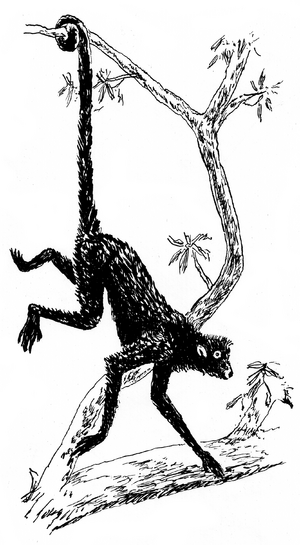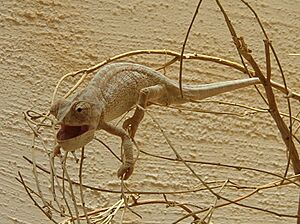Prehensile tail facts for kids

A prehensile tail is a special tail that an animal can use to grab or hold onto things. Think of it like an extra hand! Animals with these tails can use them to hold objects, climb trees, or even hang upside down. The word prehensile comes from a Latin word meaning "to grasp" or "to take hold of."
Some animals have tails that are fully prehensile. This means they can use their tails almost like a hand to pick up food or move objects. Other animals have partially prehensile tails. These tails are great for balancing, climbing, or holding onto a branch, but they might not be strong enough to pick up things.
Contents
Animals with Fully Prehensile Tails
Many different animals have tails that can grasp and hold. These tails are super useful for living in trees or finding food.
Mammals with Grasping Tails
- New World Monkeys: Many monkeys from Central and South America, like howler monkeys, spider monkeys, and woolly monkeys, have strong grasping tails. These tails often have a bare, sensitive patch on the end, which helps them get a better grip. This is different from monkeys in Africa and Asia, who do not have prehensile tails.
- Opossums: These marsupials live in the Americas. Opossums have been seen using their prehensile tails to carry things like nesting material!
- Anteaters: Three out of four types of anteaters, including the silky anteater and the two kinds of tamanduas, have prehensile tails. They use them to help climb trees.
- Binturongs: This animal is also called a "bearcat." It's one of the few animals from the Old World (Asia and Africa) with a fully prehensile tail. They use just the very tip of their tail to hold on.
- Kinkajous: Found in South and Central America, the kinkajou is another animal that uses its tail to grasp. It's related to raccoons!
- Harvest Mice: The Eurasian harvest mouse is a tiny mouse from the Old World. It has a fully prehensile tail that helps it climb and move through tall grasses and plants.
- New World Porcupines: Some porcupines, like those in the Coendou and Chaetomys groups, have fully prehensile tails. These tails are important for climbing trees and stopping them from falling.
- Tree Pangolins: This is another Old World mammal with a fully prehensile tail. Pangolins are unique animals covered in scales.
- Long-tailed Tenrec: The Microgale longicaudata is a small, tree-dwelling animal from Madagascar that has a prehensile tail.
Fish with Grasping Tails
- Seahorses: Seahorses have amazing prehensile tails! They use them to hold onto things like seagrass, coral, or even ropes. This stops them from drifting away in the water.
Animals with Partially Prehensile Tails
Some animals have tails that can help them climb or balance, but they aren't quite as strong or flexible as fully prehensile tails.
Mammals with Climbing Tails
- Capuchin Monkeys: While very smart, the capuchin monkey's tail doesn't have the bare skin patch needed for a super strong grip. So, they mostly use it for climbing and hanging, not for picking up objects.
- Tree Porcupines: All 15 types of tree porcupines in the genus Coendou have prehensile tails. They live in South America and use their tails to help them climb.
- Rats: Rats can wrap their tails around objects for a little extra balance. They can even hang briefly from things, but not for very long.
- Possums: This large group of marsupials from Australia and nearby islands all have prehensile tails. However, some, like the Acrobatidae, have only a limited ability to grasp.
- Potoroids: This group of Australian marsupials includes bettongs and potoroos. They have tails that are weakly prehensile.
- Monito del Monte: This small marsupial from South America also has a prehensile tail.
Reptiles with Climbing Tails

- Prehensile-tailed Skinks: Several types of skinks, like Corucia zebrata, have tails that can grasp.
- Chameleon Lizards: Chameleons are famous for their color-changing skin and their prehensile tails, which help them move through branches.
- Snakes: Many snakes have a prehensile tail, or even a prehensile body, which helps them climb and hold onto branches.
- Crested Geckos: These geckos and their relatives have prehensile tails that help them climb.
- Udzungwa Gecko: The Urocoyledon rasmusseni is a gecko found in the Udzungwa mountains that has a prehensile tail.
- Alligator Lizards: Some alligator lizards, like the southern alligator lizard and the Texas alligator lizard, have prehensile tails.
- Big-headed Turtles: Young turtles of the Chelydridae family also have prehensile tails.
Amphibians with Climbing Tails
- Salamanders: A number of climbing salamanders in North America have prehensile tails. These tails help them climb trees and other surfaces. Examples include the clouded salamander and the wandering salamander.
Fish with Climbing Tails
- Syngnathidae: Many species in this group, which includes seahorses and pipefish, have prehensile tails.
See also
 In Spanish: Cola prensil para niños
In Spanish: Cola prensil para niños


